Citation: Taylor, G. J. (Sept, 2022) Detailed Microanalysis of One Lunar Rock Provides Insight into Formation of the Entire Lunar Magnesian Suite, PSRD, http://www.psrd.hawaii.edu/Sept22/lunar-magnesian-suite.html.
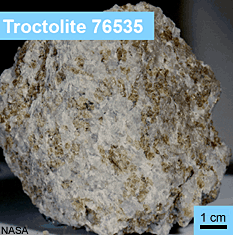
|
September 17, 2022
Detailed Microanalysis of One Lunar Rock Provides Insight into Formation of the Entire Lunar Magnesian Suite
--- The distribution of phosphorous in olivine and sodium in plagioclase in lunar rock 76535 suggest that its formation may have involved reaction between magma ocean products and magma formed by partial melting in the lower crust.
Written by G. Jeffrey Taylor
Hawai'i Institute of Geophysics and Planetology
The lunar crust contains three major rock types: anorthosites, which make up most of the lunar highland crust; mare basalts, the smooth dark regions that decorate the lunar hemisphere facing the Earth; and the magnesian suite (Mg-suite), which occur as coarse-grained igneous rocks. Lunar scientists have a reasonably good handle on the origin of the first two rock types, but formation of the Mg-suite rocks has baffled them. This long-lasting befuddlement may have ended thanks to detailed maps of the distribution of phosphorous (P) in olivine crystals and sodium (Na) in plagioclase feldspar crystals in lunar troctolite 76535 (troctolite are igneous rocks composed mostly of the minerals olivine and plagioclase). Using an electron microprobe, Will Nelson, Julia Hammer, Tom Shea, Eric Hellebrand, and Jeff Taylor (all at the University of Hawaiʻi; Eric Hellebrand is now at Utrecht University in The Netherlands), show that olivine contains areas enriched in P that alternate with areas containing very little P, with sharp boundaries between them. The authors interpret these crystal-chemical features as evidence for dissolution and reprecipitation caused by reaction between the growing crystals and an intruding magma, a process called reactive melt infiltration. All this action took place at the base of the anorthosite layer and involved reaction between anorthosite and urKREEP (formed from the last few percent of the magma ocean) with rising plumes of Mg-rich olivine from the deep mantle.
Reference:
- Nelson, W. S., Hammer, J. E., Shea, T., Hellebrand, E., and Taylor G. J. (2021) Chemical Heterogeneities Reveal Early Rapid Cooling of Apollo Troctolite 76535. Nature Communications, v. 12, doi: 10.1038/s41467-021-26841-4. [article]
- PSRDpresents: Detailed Microanalysis of One Lunar Rock Provides Insight into Formation of the Entire Lunar Magnesian Suite --Slide Summary (with accompanying notes).
Rock Types Making Up the Lunar Highlands
The lunar surface is decorated with lighter and darker areas. The dark places, called maria, are composed of solidified basalt lava flows. They make up about 17% of the surface of the Moon and only about 1% of the total volume of the lunar crust. The more abundant light-colored areas called the lunar highlands are higher and older than the maria. Most of the rocks in the highlands are composed mostly of plagioclase feldspar, a rock type called anorthosite. They are coarsely crystalline rocks full of calcium-rich plagioclase (averaging about 96 vol% plagioclase) and have low magnesium/iron ratios, low sodium/calcium, and low concentrations of incompatible lithophile trace elements such as rare earth elements. Intermingled with the anorthosites in the highlands are rocks containing less plagioclase plus an iron-and-magnesium-bearing silicate, either olivine (called troctolites), low-Ca pyroxene (called norites), or high-Ca pyroxene (called gabbros). These rocks have relatively high magnesium/iron compared to anorthosites and have been dubbed the magnesian (Mg) suite. The Mg-suite rocks returned by the Apollo missions to the lunar nearside have higher trace-element concentrations, hence are enriched in KREEP compared to the anorthosites. Lunar meteorites derived from the highlands also contain pieces of Mg-suite norites and troctolites, but many are not enriched in the KREEP component; they may reflect the composition of the highlands far from the prominent KREEP-rich Procellarum KREEP Terrane on the lunar Earth-facing hemisphere (see PSRD article A New Moon for the Twenty-First Century).
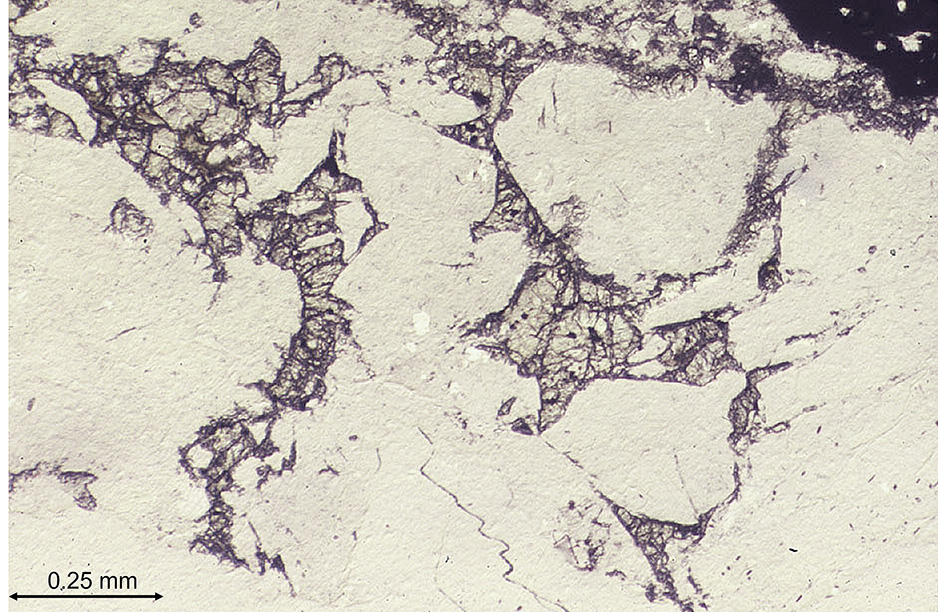 |
| Photomicrograph of an anorthosite clast in lunar highlands breccia 67915 (Apollo 16 site, in the lunar highlands). The abundant lighter areas are plagioclase. The grains that stand out are pyroxene. Plagioclase is much more abundant that pyroxene. The pyroxene crystals appear to have formed around pre-existing plagioclase crystals, a hallmark of cumulate rocks. |
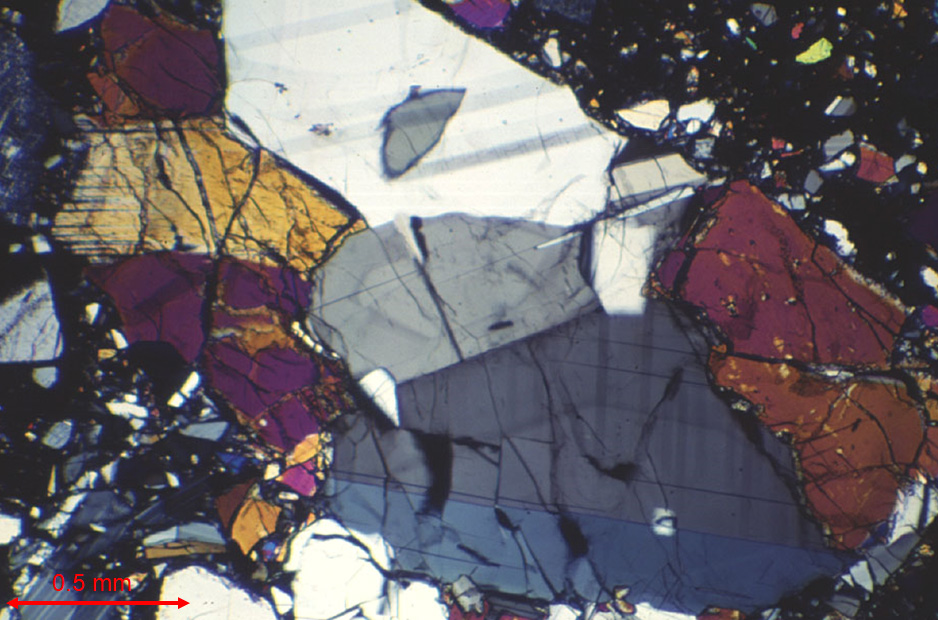 |
| Typical Mg-suite rock. This one is a rock fragment in an impact breccia, collected at the Apollo 17 landing site. In this photomicrograph, the grayish mineral is plagioclase, orange to reddish mineral is orthopyroxene, showing that this rock is a norite. |
For a summary of the rocks in the lunar highlands, see PSRD article Unraveling the Origin of the Lunar Highlands Crust.
The Moon's Mysterious Magnesian Suite
The Mg-suite of lunar rocks has the disturbing, paradoxical properties of high magnesium (Mg) to iron (Fe) ratios coupled with high concentrations of incompatible trace elements such as the rare earth elements. They are called "incompatible" because they concentrate in magmas, not in major minerals. In typical crystallizing magmas, the first crystals to form, such as olivine, have high Mg/Fe, but low incompatible trace element abundances. By the time the trace element concentrations have increased substantially in the molten portion of the system, the Mg/Fe has plummeted. Geochemical common sense tells us that high Mg/Fe coupled with high incompatible trace elements is contradictory. So how did those Mg-suite magmas form?
Lunar scientists have been pondering this question since the Mg-suite was identified in the early 1970s. Quite a few ideas for the origin of the Mg-suite were proposed over the years, all involving crystallization of a lunar magma ocean, followed by an imaginative assortment of petrologic processes leading to creation of magmas with the right geochemical properties to crystallize as Mg-suite rocks. One important piece of information is the physical conditions in which Mg-suite rocks formed. For example, using the compositions of minerals in lunar troctolite 76535 and thermodynamic calculations Ron Gooley and co-authors at the Johnson Space Center showed in an interesting paper published in 1974 that this rock formed and cooled at a depth of between 10 and 30 kilometers in the lunar crust. Gooley's and other subsequent research on 76535 suggest that the rock cooled slowly (1-50 oC per million years), consistent with deep burial. This was highly informative, but Will Nelson and co-workers wanted more details about the physical environment in which troctolite 76535 formed. They turned to measuring the distribution of minor elements in olivine and plagioclase crystals.
Troctolite 76535
Troctolite 76535 was collected as a rake sample near several large boulders of impact breccia (about 5 to 10 meters across) at the base of North Massif at the Apollo 17 site. Rake samples were collected using (obviously) a rake. The prongs of the rake were a centimeter across, allowing astronauts to collect only rocks larger than a centimeter. (The idea was to gather a random sampling of rock fragments large enough for numerous sophisticated geochemical analyses.) Astronaut Jack Schmitt commented about the rock fragments collected that, "A couple of them look fairly coarsely crystalline." Once examined in the Lunar Curatorial Laboratory back on Earth, one of those sparking samples eventually got the number 76535. It had a mass of 155 grams. The rock is the only Mg-suite rock that appears undamaged by meteoroid impacts over billions of years, despite being excavated by a huge impact and tossed to help make the mountains surrounding the valley in which Apollo 17 landed.
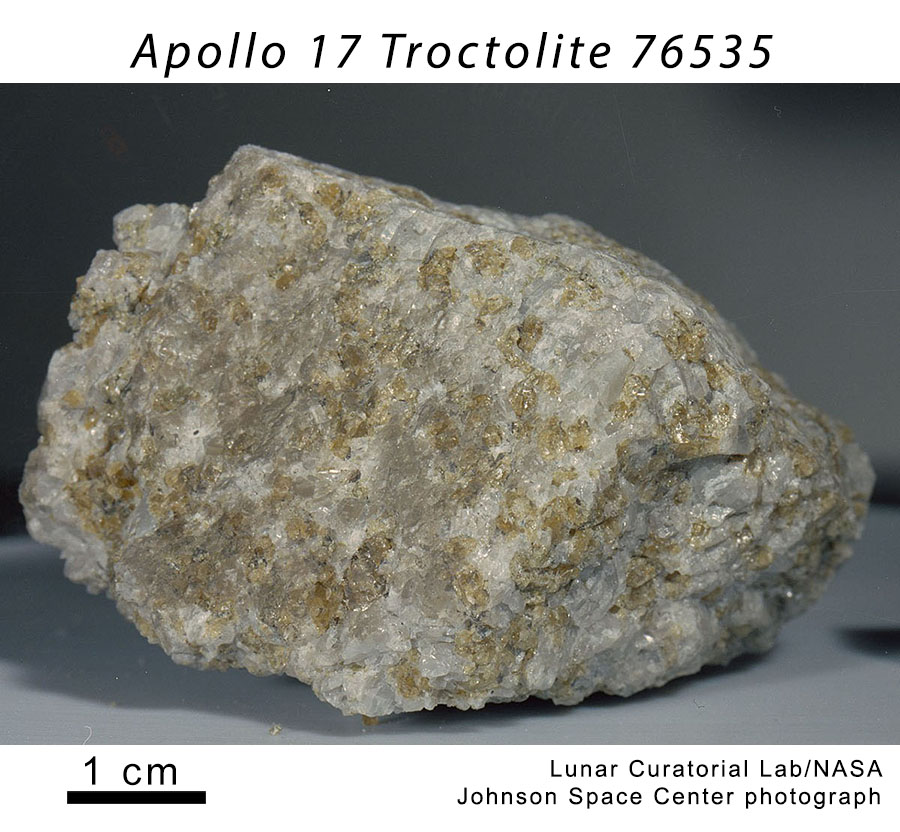 |
| Troctolite 76535 (plagioclase plus olivine) was collected by the Apollo 17 crew in Taurus-Littrow Valley. |
Will Nelson used optical microscopy to identify suitable olivine and plagioclase grains in two thin sections (76535,46 and 76535,52 for those keeping score) of troctolite 76535. The suitability of grains was based on crystal shapes that preserved their igneous crystallization and did not have interior cracks. He then made X-ray intensity maps of appropriate grains and careful quantitative analyses across individual grains of both minerals.
The most startling discovery from these analyses is the presence of lamellae (thin plates) where phosphorus (P) is distinctively enriched in olivine. The P concentrations are not high, less than 0.1 wt% P2O5, but show sharp boundaries with areas that are much lower in P. This has also been observed in olivine in terrestrial basalts and in melting experiments in Julia Hammer's experimental laboratory in the Department of Earth Sciences at the University of Hawaiʻi. A study of samples collected on the submerged slopes of Hualālai Volcano, Hawaiʻi, by Benoit Welsch, Julia Hammer, and Eric Hellebrand shows that P-rich areas grew as dendrites (like snowflakes). These striking features indicate initial fast growth of olivine. The rapid growth of olivine allows P to be incorporated into its crystal structure because phosphorus enters olivine if its diffusion in the melt is slower than the rate at which olivine grows. The snowflake model suggests that all the P-rich parts of the crystal grew over a short period of time and all the P-poor areas were back-filled later on, when growth was less rapid. Plagioclase is also zoned, with higher sodium near crystal edges than in the interiors, though the heterogeneities are not as striking as the parts of olivine grains that have enhanced phosphorus concentrations.
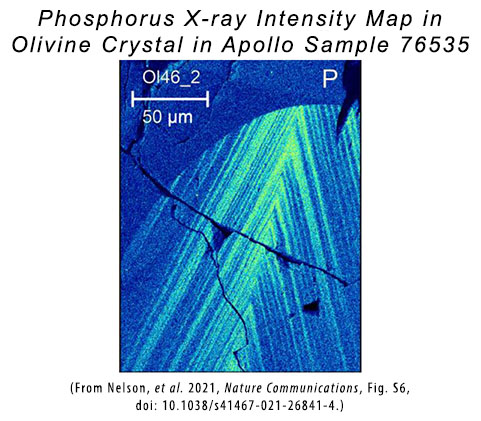 |
| X-ray map of the distribution of P in olivine from troctolite 76535. The lamellae are interpreted as due to rapid growth of olivine, which allows P to be incorporated into its crystal structure. The incorporation of P into the olivine continues as long as the rate at which olivine grows exceeds the rate at which P diffuses in the magma. |
This is a good story that is backed up by laboratory experiments. However, the distribution of elements in olivine and plagioclase and the curvy boundaries between olivine and plagioclase in 76535 indicate that annealing took place, which requires the cooling rate to have decreased after the rock had crystallized. This led Will Nelson and colleagues to calculate the cooling times necessary to preserve the phosphorus lamellae. The calculations used standard (in fact, classic) equations that quantify diffusion and published measurements of how fast phosphorus migrates (diffuses) inside olivine crystals (captured by the "diffusion coefficient," which is dependent on temperature). They also used the distribution of sodium and calcium in plagioclase to calculate the cooling times required to produce the observed variation in sodium in plagioclase while preserving the distribution of phosphorus in olivine. These calculations are computationally intensive (hundreds of thousands to millions of calculations for each crystal!) and required use of the University of Hawaiʻi High Performance Computer Cluster. (Disclaimer: I had nothing to do with the diffusion programming for a program to run on a supercomputer. I am more inclined to use Excel on a PC.)
Previous estimates of the cooling rate of 76535 by Lars Borg (Lawrence Livermore National Laboratory) and colleagues were based on the measured ages of the rock as determined from four different isotopic dating systems. That approach suggests that the magma body in which troctolite 76535 formed cooled at 3.9oC/million years. This cooling rate applies to a temperature of around 800oC. The Nelson calculations show that the cooling rate could not have been that slow throughout the cooling of the magma body in which the troctolite formed. If cooling at 3.9oC/My from the crystallization temperature of 1297oC for olivine (estimated from numerous previous experiments on crystallization of olivine in magma) the phosphorus-enriched lamellae would be erased in only 10 years. Doing similar calculations for plagioclase, the team found that the zonation of sodium in plagioclase would be erased in about 20 million years.
These analyses and calculations imply that the initial cooling was many orders of magnitude faster at the beginning of magma crystallization than at lower temperature. Although not impossible, a rate over a million times faster initially than later seemed a tad unreasonable. But there is a way out of this inconsistency: There is always some uncertainty in the determination of diffusion coefficients. As Nelson and coworkers point out, if phosphorus diffused at the same rate silicon does in olivine, which is way slower than published measurements of phosphorus diffusion, the phosphorous concentration variations would be ironed out in 27 million years, not too different from the cooling times to homogenize the plagioclase. Whatever the details, the conclusion is that the magma and its crystallization products cooled much faster at high temperatures than at lower temperatures (as recorded by the age dating isotopic measurements).
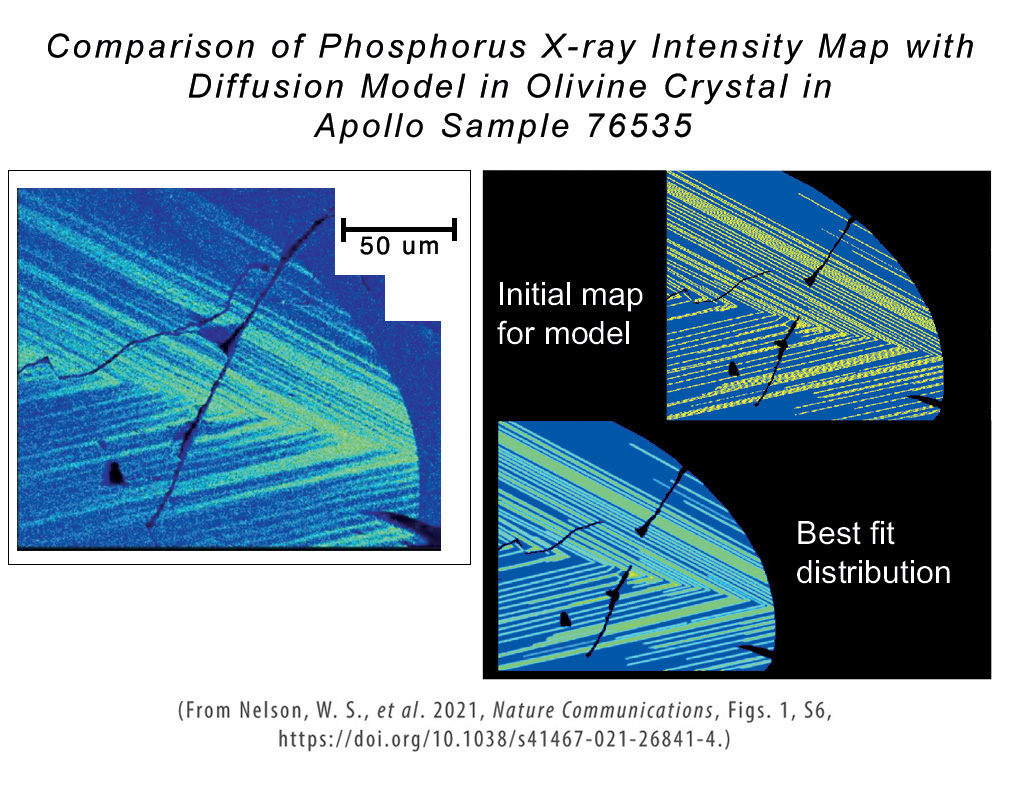 |
| [Left] P distribution in olivine crystal in troctolite 76535. [Right] the initial P distribution used for diffusion calculations and the best fit to the calculations. Nelson and coworkers tried numerous initial distributions to determine the cooling times necessary to match the observed distribution. |
Implications for the Formation of the Mg-suite
We do not know how the Mg-suite formed. Well, that's not exactly right. There are several ideas for how it formed, all worth considering, but no agreement on which one is most likely. Will Nelson and team have presented new data on the physical setting in which troctolite 76535 formed. It formed in a magma system that crystallized olivine at high temperature and cooled fast enough to allow P to enter growing olivine grains, creating the stunning P-enriched areas. Plagioclase formed at about the same time, becoming zoned with sodium concentrations increasing with crystallization, hence enriched towards the edges of plagioclase crystals. At some point the cooling rate decreased substantially.
This suggests that the olivine crystals in 76535 formed early in an environment in which magma could lose heat rapidly, followed by surroundings that lost heat much more sluggishly. For magmas, this implies starting with a smallish batch of magma then immersing it in a much larger, hence more slowly cooling one. A process like that cannot happen in what we geologists call layered intrusions—big bodies of subsurface magma that cool slowly, in which crystals form and are sorted by their densities. These big (tens of kilometers across and about ten kilometers thick) underground masses of magma differentiate into layered deposits, with the denser minerals concentrated close to the bottom. (It is much more complicated than just sinking of heavy crystals.)
Will Nelson and his colleagues took a leaf from the terrestrial igneous notebook, suggesting that processes that occur at mid-ocean ridges on Earth might have operated during formation of the Mg-suite on the Moon. They suggest that reactive melt infiltration played a central role in the petrogenesis of the Mg-suite of lunar rocks. What's reactive melt infiltration? It sounds disturbingly like a medical procedure, but it is a physical/chemical process that has been used in materials science for a long time and has been applied to understanding magmatism at mid-ocean ridges and in the Earth's mantle.
When the Moon formed it was almost entirely molten, with a small metallic core at its center (probably molten, too). This huge magma system was dubbed "the lunar magma ocean." As it cooled, olivine crystals formed (near the top where heat was being lost to space and at the bottom due to the higher pressure) and because the solid crystals were denser than the melt, they sank and formed the primitive mantle. After about 40% of the magma ocean had crystallized as olivine, orthopyroxene (low-Ca pyroxene) began to crystallize, and probably mixed with the mantle olivine. After about 80% crystallization, plagioclase joined the crystal assemblage, but because its density was lower than the density of the now-modified magma ocean, it floated, accumulating into a thick crust of plagioclase-rich rock called anorthosite. (The high abundance of plagioclase in the lunar highlands is an important line of evidence for the existence of the magma ocean.) In the final stages of crystallization high-Ca pyroxene and ilmenite joined in the magma ocean festivities.
During crystallization of this massive magma body many elements were not incorporated into the crystallizing minerals. These crystal-shy elements are those that characterize KREEP (potassium, rare earth elements, phosphorus, thorium, uranium, and a bunch of others). Their reticence arises because they are large ions and simply do not fit into the crystal lattices of the major minerals. The result is that they remain in the melt. Because removal of the main minerals decreases the amount of melt remaining, the concentration of these trace elements increases with crystallization. (All this can be quantified.) In round numbers, the last couple of percent of magma ocean melt contains 50 to 100 times the concentration of KREEP trace elements. These last dregs of the magma ocean probably resided beneath the anorthosite crust and above the last minerals to have crystallized, which made up a disheveled pile of dense minerals. Paul Warren and John Wasson (University of California, Los Angeles) named this trace element region "urKREEP," the component ready to infiltrate magmas to make KREEP rocks. (For linguistically inclined readers, "ur" is a German prefix for earliest, primeval, or primitive.)
The stack of magma ocean products has all the ingredients for the Mg-suite troctolite recipe: Magnesian-rich olivine, plagioclase, and plenty of KREEP. It would seem to be a problem that olivine is at the bottom and the plagioclase is at the top. However, it is not really a problem because the deep, magnesian-rich olivine is less dense than the overlying rock, hence would move up as large blobs (geologists call them plumes) before stalling at the base of the rigid crust. Such motions are possible because hot rocks are deformable and behave as highly viscous liquids. They deform like hot plastic. Steve Elardo and colleagues at the University of New Mexico (Elardo is now at the University of Florida) suggest that once a plume of mantle rock reaches the low-density crust it could react with feldspar-rich rock and urKREEP to produce the magmas that gave rise to the numerous igneous rock bodies known as the magnesian suite (see PSRD article Crystallizing the Lunar Magma Ocean).
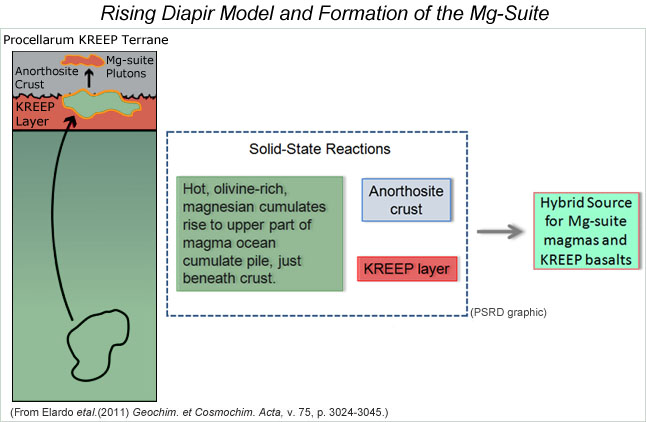 |
| [Left] Model devised by Elardo and colleagues for creation of a hybrid, shallow source for production of Mg-suite magmas. [Right] Schematic showing how the three major magma ocean products could react to make a hybrid source for the Mg-suite magmas. Rising magnesian cumulates from the magma ocean slowly smash into the urKREEP layer and the anorthosite crust where all three react to form a hybrid rock. This rock subsequently partially melts to produce the Mg-suite magmas. |
Will Nelson and colleagues add a rich level of detail to this idea. Like Steve Elardo and colleagues, they suggest that the rising blobs of olivine-rich mantle mechanically mix with the crustal plagioclase and urKREEP, creating a hybrid rock. These hybrid areas would be complicated mixtures with contact areas in the centimeter to meter size range. The hot olivine from depth would provide heat to the already-hot system, causing the chaotic mixture to partially melt. In fact, the arriving blobs would probably have already partially melted by moving from a high-pressure regime at depth to a much lower pressure regime at the base of the crust. This melting would take place throughout a large volume of crust and uppermost mantle. Unsteady melt production and pulsating porous flow through the mushy volume of minerals and melt during the interaction of the mingled parent lithologies could produce the cycles of local olivine and plagioclase dissolution-reprecipitation that are required to explain the incorporation of phosphorus into growing olivine crystals, and, importantly, reconcile the thermal implications of the newly discovered sharp phosphorus lamellae in the olivine (fast cooling through magmatic temperatures) with the curvy plagioclase-olivine grain boundaries (slow regional cooling below 800oC.
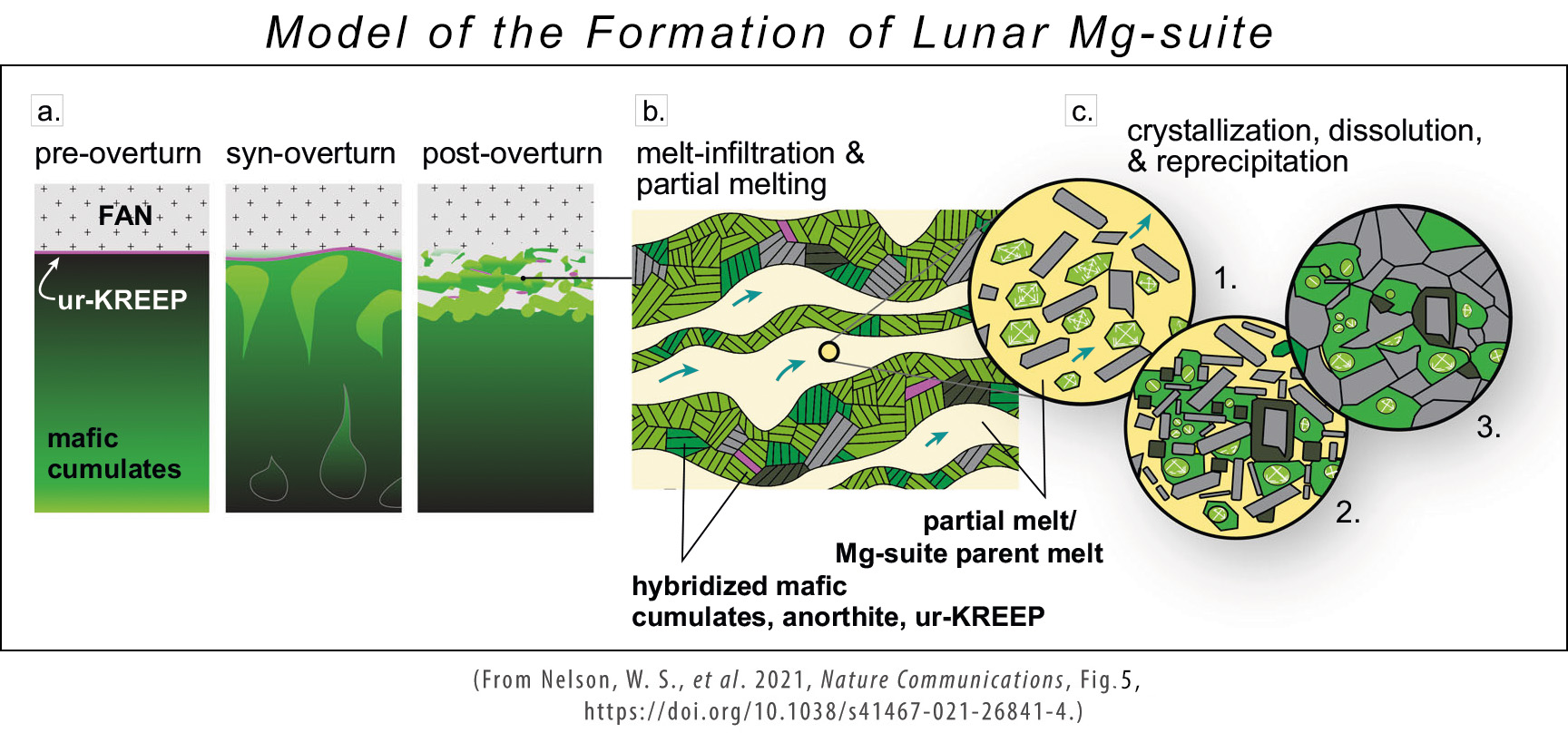 |
| [a] Mg-rich lower mantle interacts with a warm anorthosite crust and ur-KREEP, mechanically mixing the three components. The panel on the left depicts the result of magma ocean crystallization, as shown above. Dense plumes of late-stage magma ocean products sink while early formed, magnesium-rich olivine (and orthopyroxene) rise. The rising olivine-rich plumes smash into the crustal lithologies mechanically mixing them. [b] Partial melting occurs; the liquid infiltrates the surrounding rock and accumulates in lenses on the centimeter to meter scale. Melt production is pulsating, causing crystallization and dissolution during olivine growth. The hybridized mantle and crust source rocks can cause the thin melt layers to cool fast enough to allow for incorporation of phosphorus into olivine. [c] Microscopic views of rapid initial crystallization followed by dissolution and crystallization of plagioclase (gray), olivine (green), and orthopyroxene (dark green) during rapid cooling. As the magma temperature approaches the temperature of the surroundings, the cooling rate slows. Grains anneal during protracted subsolidus cooling. [Caption modified from Nelson et al., 2021.] |
Next Steps in Understanding the Origin of the Mg-suite
These detailed studies have been made on only one Mg-suite rock. We need more samples, from both the nearside and farside of the Moon. Lunar meteorites are an excellent resource, but we do not know exactly where they come from on the Moon. As NASA prepares to resume human missions to the Moon, it is time to think about good targets for field work to sample Mg-suite rocks from outcrops.
- PSRDpresents: Detailed Microanalysis of One Lunar Rock Provides Insight into Formation of the Entire Lunar Magnesian Suite -- Slide Summary (with accompanying notes).
- Borg, L. E., Connelly, J. N., Cassata, W. S., Gaffney, A. M. and Bizzarro, M. (2017) Chronologic Implications for Slow Cooling of Troctolite 76535 and Temporal Relationships between the Mg-suite and the Ferroan Anorthosite Suite. Geochimica et Cosmochimica Acta, v.201, p. 377-391, doi: 10.1016/j.gca.2016.11.021. [article]
- Elardo S. M., Draper D. S., and Shearer C. K. (2011) Lunar Magma Ocean Crystallization Revisited: Bulk Composition, Early Cumulate Mineralogy, and the Source Regions of the Highlands Mg-suite. Geochimica et Cosmochimica Acta, v. 75, p. 3024-3045, doi: 10.1016/j.gca.2011.02.033. [article]
- Gooley, R., Brett, R., Warner, J. and Smyth, J. R. (1974) A Lunar Rock of Deep Crustal Origin: Sample 76535. Geochimica et Cosmochimica Acta, v. 38, p. 1329-1339.
- Nelson, W. S., Hammer, J. E., Shea, T., Hellebrand, E., and Taylor G. J. (2021) Chemical Heterogeneities Reveal Early Rapid Cooling of Apollo Troctolite 76535. Nature Communications, v. 12, doi: 10.1038/s41467-021-26841-4. [article]
- Warren, P. H., Wasson, J.T. (1979) The Origin of KREEP. Reviews of Geophysics, v. 17, p. 73-88.
- Welsch, B., Hammer, J. and Hellebrand, E. (2014) Phosphorus Zoning Reveals Dendritic Architecture of Olivine. Geology, v. 42, p. 867-870, doi: 10.1130/G35691.1. [article]
|
|
[ About PSRD | Archive | CosmoSparks | Search | Subscribe ] [ Glossary | General Resources | Comments | Top of page ] |

